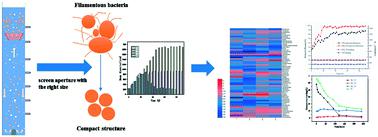当前位置:
X-MOL 学术
›
Environ. Sci.: Water Res. Technol.
›
论文详情
Our official English website, www.x-mol.net, welcomes your feedback! (Note: you will need to create a separate account there.)
The stability of aerobic granular sludge under low energy consumption: optimization of the granular size distribution by a novel internal component
Environmental Science: Water Research & Technology ( IF 5 ) Pub Date : 2021-4-10 , DOI: 10.1039/d1ew00060h Runjuan Cao 1 , Yatong Ji 1 , Taixing Han 1 , Jingsong Deng 1 , Liang Zhu 1, 2, 3 , Xiangyang Xu 1, 2, 3
Environmental Science: Water Research & Technology ( IF 5 ) Pub Date : 2021-4-10 , DOI: 10.1039/d1ew00060h Runjuan Cao 1 , Yatong Ji 1 , Taixing Han 1 , Jingsong Deng 1 , Liang Zhu 1, 2, 3 , Xiangyang Xu 1, 2, 3
Affiliation

|
To enhance the stability and pollutant removal performance of aerobic granular sludge (AGS), four groups of AGS reactors with mesh screens of different pore sizes (R1 is the control reactor; R2, R3, and R4 have pore sizes of 1.5, 2.5, and 3.5 mm, respectively) were established in this study. The results showed that the granular sludge in the reactor with a 2.5 mm mesh screen (R3) has the highest mixed liquor suspended solids (MLSS) value of 8.2 ± 0.2 g L−1 and the lowest sludge volume index (SVI30) value of 30 mL g−1. At the same time, the mature granular sludge in R3 had a compact structure and excellent total nitrogen (TN) removal performance (84.9 ± 1.2%), along with an optimal granule size distribution (span value of 96 ± 0.12). Analysis of the sludge microbial community showed that R3 has a higher enrichment of functional microorganisms, such as Zoogloea spp. (50.5%) and Thauera spp. (16.1%). This is beneficial for improving its intercellular adhesion and denitrification performance. The granule size distribution results indicated that R3 screened the growing granules with its appropriate mesh aperture in terms of optimizing hydraulic shear, thus inhibiting the growth of filamentous bacteria and keeping the granule size within the optimal range. This created a favorable niche for these fast-growing microorganisms, eventually forming granules with good stability and high denitrification efficiency.
中文翻译:

低能耗下好氧颗粒污泥的稳定性:通过新型内部组分优化颗粒尺寸分布
为了提高好氧颗粒污泥(AGS)的稳定性和去除污染物的性能,四组带有不同孔径筛孔的AGS反应器(R1是控制反应器; R2,R3和R4的孔径分别为1.5、2.5和1.5)。在这项研究中分别建立了3.5毫米)。结果表明,采用2.5毫米筛孔(R3)的反应器中的颗粒污泥的最高混合液悬浮固体(MLSS)值为8.2±0.2 g L -1,而污泥体积指数(SVI 30)最低。 30毫升g -1。同时,R3中的成熟颗粒污泥具有紧凑的结构和出色的总氮(TN)去除性能(84.9±1.2%),以及最佳的粒度分布(跨度值为96±0.12)。对污泥微生物群落的分析表明,R3具有较高的功能微生物含量,例如动物链藻(Zoogloea spp)。(50.5%)和Thaueraspp。(16.1%)。这对于改善其细胞间粘附和反硝化性能是有益的。颗粒大小分布结果表明,R3在优化水力剪切方面筛选了具有合适筛孔的生长颗粒,从而抑制了丝状细菌的生长,并将颗粒大小保持在最佳范围内。这为这些快速生长的微生物创造了有利的环境,最终形成了具有良好稳定性和高反硝化效率的颗粒。
更新日期:2021-05-07
中文翻译:

低能耗下好氧颗粒污泥的稳定性:通过新型内部组分优化颗粒尺寸分布
为了提高好氧颗粒污泥(AGS)的稳定性和去除污染物的性能,四组带有不同孔径筛孔的AGS反应器(R1是控制反应器; R2,R3和R4的孔径分别为1.5、2.5和1.5)。在这项研究中分别建立了3.5毫米)。结果表明,采用2.5毫米筛孔(R3)的反应器中的颗粒污泥的最高混合液悬浮固体(MLSS)值为8.2±0.2 g L -1,而污泥体积指数(SVI 30)最低。 30毫升g -1。同时,R3中的成熟颗粒污泥具有紧凑的结构和出色的总氮(TN)去除性能(84.9±1.2%),以及最佳的粒度分布(跨度值为96±0.12)。对污泥微生物群落的分析表明,R3具有较高的功能微生物含量,例如动物链藻(Zoogloea spp)。(50.5%)和Thaueraspp。(16.1%)。这对于改善其细胞间粘附和反硝化性能是有益的。颗粒大小分布结果表明,R3在优化水力剪切方面筛选了具有合适筛孔的生长颗粒,从而抑制了丝状细菌的生长,并将颗粒大小保持在最佳范围内。这为这些快速生长的微生物创造了有利的环境,最终形成了具有良好稳定性和高反硝化效率的颗粒。



























 京公网安备 11010802027423号
京公网安备 11010802027423号